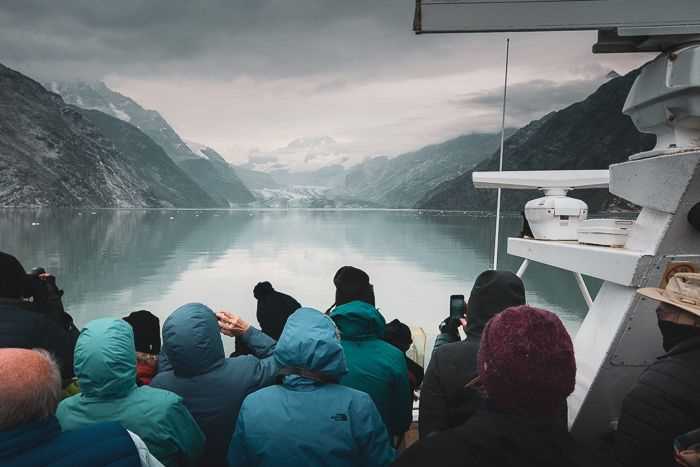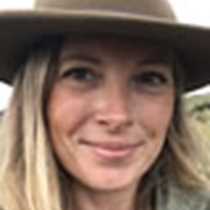We arose before the fishermen today to begin a very special operation to Glacier Bay National Park. The water was calm and the sky a soft rose as we shuttled off for the docks in Gustavus for our short transit by bus to Bartlett Cove and the visitor’s center of the park.
At Bartlett Cove we boarded the Baranoff Wind, one of only a few boats permitted to enter the waters of Glacier Bay each year. She would take us on a fast clip to make the 130-nautical-mile roundtrip in a single day.
Glacier Bay is a sacred land to the Tlingit Tribe, a land dominated by sea and ice and extraordinary geology. Here, the rock is alive with the evidence of fiery reshaping and tectonic activity, not to mention the glacial upheaval that continues to literally carve the land.
Captain George Vancouver, sailing on the H.M.S. Discovery, first explored what we now call Glacier Bay in 1794. This bay at one time was almost completely covered in ice by a glacier that extended to within five miles of the bay’s opening. Today that glacier has retreated more than 65 miles inland. As the ice retreated, the ground beneath rose upwards, relieved of the weight of the ice. The retreat has created what we call a natural laboratory, where naturalists and researchers, including John Muir could observe the transformation of land from seemingly lifeless rock to a bountiful forest. Today you can still see the evolution of the land from rock to mossy undergrowth to virgin forest.
Our goal aboard the Baranoff Wind was to reach the edge of the Johns Hopkins Glacier, a massive glacier backed by the snow-capped peaks of the Fairweather Mountains. On our way we passed a series of islands, including one called South Marble Island. Guests clamored to the deck as our eyes fell upon an island that appeared to be made more of sea lions, puffins and murres than of rock. Deep, belching rumbles echoed from the rock slopes as stellar sea lions jostled for space. The bark of a California sea lion surprised our ears. It had somehow made its way this far north to hang out with its larger cousins.
We continued up the bay, past Tlingit Point, spotting mountain goats among the cottonwoods that lined the ridge tops, and even caught glimpse of a brown bear as it fished at the mouth of a stream. Johns Hopkins Glacier did not disappoint. Hundreds of gulls swirled along the base of the glacier as water raged from beneath the ice, stirring the sediment, fish and other goodies for them to eat. Almost a thousand harbor seals dotted the ice flows and when the glacier spoke and a thunderous cracking filled the air, we all fell silent.
After listening to the glacier, we made the trip back to Bartlett Cove, waving at the bear, humpbacks and sea otters we saw along the way. Once back on land, we were greeted by Sonya, a member of the Tlingit Tribe of Hoonah and a park ranger. She invited us into a long house, built in 2016 and the first of its kind in more than 250 years. Sonya, whose father is the leader of the Raven Clan, told us stories of her history, including the story of the Little Black Glacier, a small glacier that moved as fast as a dog could run and displaced her people. This glacier then became the Big Glacier. She told us the stories of the Raven and three Eagle clans that shared this land, and how they survived the movement of the glacier, then the years of eternal winter that covered everything in snow. The winter that lasted for two years is now believed to be the result of massive volcanic eruptions that filled the sky with ash and dropped most of the planet into freezing temperatures. She spoke of earthquakes and the largest tsunami in recorded history that swamped the forest. These cataclysmic events cut food and resources in half almost instantaneously. But her stories were not ones punctuated by disaster. They were stories revealing great strength and resilience. Today that resilience is beautifully rendered in the carvings and story wall of the long house in Glacier Bay.
After hearing her stories, no mere downpour was going to stop us from exploring the surrounding forest. I joined a hike with Sharon Grainger, and she was like a child with her favorite toy as she discovered mushrooms and lichen of all varieties growing happily from the mossy ground. We spotted hedgehog mushrooms, yellow coral mushrooms, even a fungus that was growing on fungus. It was like something out of a fairytale.
That walk in the rain rejuvenated us after the long boat ride, and as we boarded from the docks to return to National Geographic Sea Lion, we watched as the ship’s namesake, a lone Steller sea lion, smacked the water with a halibut it had harvested from the bountiful waters of Glacier Bay.







